This comprehensive guide focuses on the setup of a Google AdWords campaign for roofing. Google Ads is a potent tool that roofing companies can use to enhance their marketing efforts by drawing in targeted audiences and effectively promoting their services.
Regardless of your level of experience in marketing or level of familiarity with online advertising, this blog seeks to provide you with the information and tactics required to build an efficient and profitable Google Ads campaign
Table of Contents
We’ll walk you through every step of the process, from fine-tuning your campaign settings to selecting the best keywords to use in your ad copy. Follow along as we explore the world of roofing marketing and uncover how Google AdWords can generate leads, boost brand awareness, and eventually expand your roofing company.
Introducing Google Ads
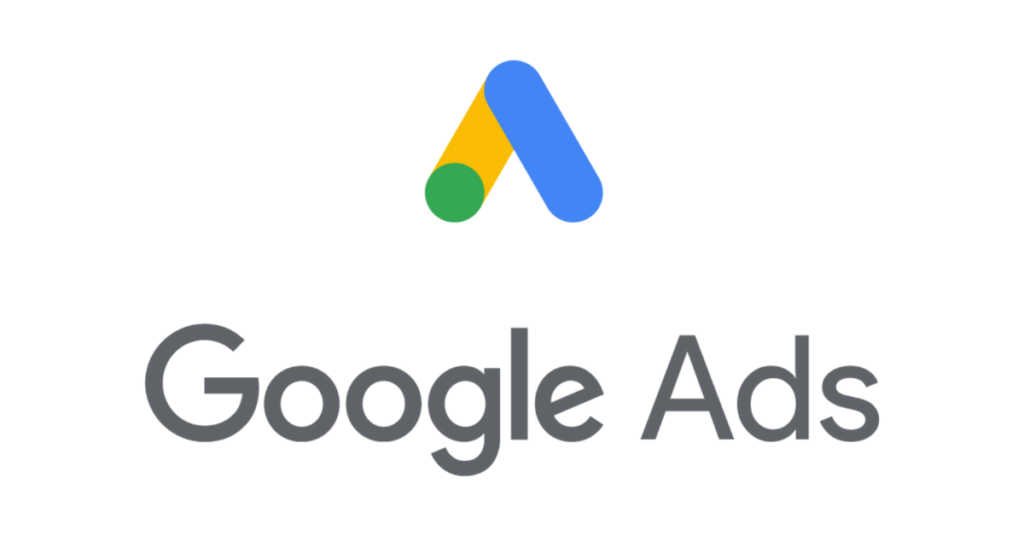
Using Google Ads, you can run Pay-Per-Click (PPC) ads on the search engine and pay Google each time your ad appears. Google Ads offer many benefits that you can take advantage of. In the end, it’s a fantastic method to advertise your company in order to connect with your target market and increase website traffic.
The Basics of Google Ads for Roofing Companies
In the roofing industry, it’s critical to reach prospective clients at the right time. You can accomplish this by putting your roofing services in front of prospective clients when they’re looking for you through Google AdWords. We’ll go over the essentials of establishing an effective Google AdWords campaign for your roofing company in this section.
The first step is to register for a Google AdWords account and launch your first campaign. Look up relevant search terms that prospective clients use to find roofing services. It’s critical to consider the terms a prospective customer might use to find a roofing company. Selecting keywords with a high search volume and low competition will help you rank higher in search results, so choose wisely.
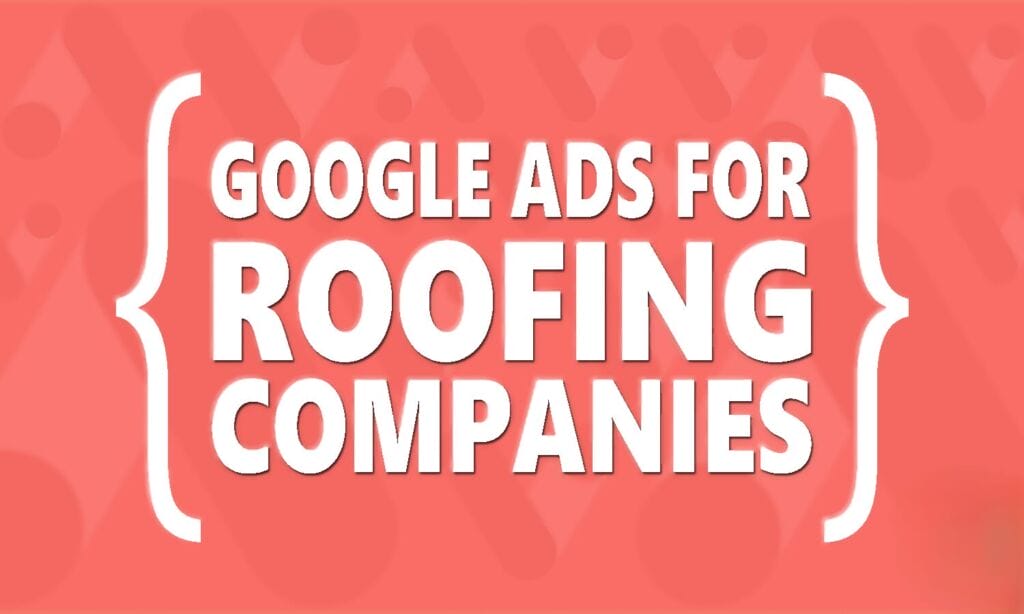
Next, write informative and engaging advertisement copy. In addition to emphasizing the advantages of using your roofing services, your advertisement should include a call to action encouraging prospective clients to get in touch with you. For increased exposure and greater relevancy to the search terms, make sure the ad copy contains your targeted keywords.
Estimate how much you are willing to pay per click (CPC) and use that figure to set your campaign’s budget. We recommend starting with a modest budget and gradually increasing it as you start observing results. Furthermore, Google AdWords provides a range of bidding strategies from which you can select the one that best suits your campaign’s goals and financial constraints.
Establishing your target audience is an important step when starting a Google Ads campaign. It is possible to set parameters related to location, interests, and demographics. It would be prudent, for example, to restrict your ads to homeowners in your service area.
Finally, keep a close eye on and improve your Google Ads campaign. Make sure you are reaching the right people and getting the desired results by regularly evaluating the performance of your advertisements. Make data-driven decisions, such as modifying your ad copy, reallocating your budget, or changing your keyword strategy, by utilizing insights from your Google Ads dashboard.
Why are Google Search Ads the right choice for marketing for roofing contractors?
Because of its ability to target users, Google AdWords is the best choice for roofing contractors.
With Google’s Search Ads, you can target potential customers in a variety of demographics and anywhere you want.
You can ensure that your advertisements appear when someone types in the good or service you offer (as long as you have enough budget).
You can configure your ads for roofers to appear when users enter terms such as:
- local roof repair
- Roof replacement agency
- Emergency roofing services
Your search advertisement targets people who are actively looking for your service, whereas a billboard displays it to everyone who drives by, regardless of whether they are interested in your offerings.
You lure them in with your advertisement and direct them to your website so they can make an appointment, get a quote, or give you a call.
Creating Your First Google Ad Campaign for Roofing Businesses
You are prepared to launch your first Google Ads Campaign now that you have set up your Google Ads account! The steps to creating your first campaign are as follows:
Establish Your PPC Ads Objective
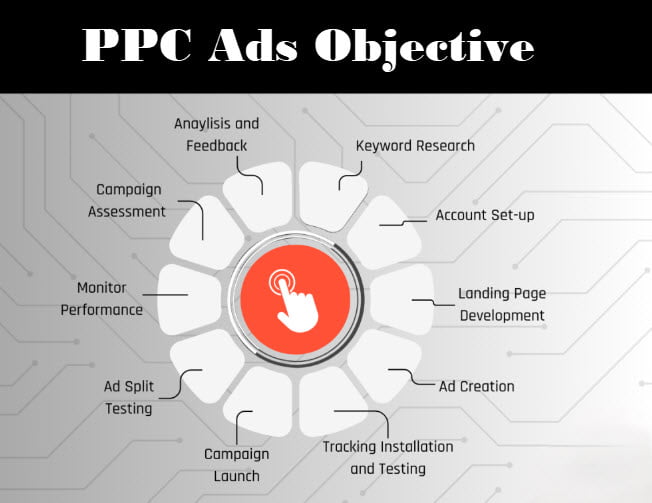
Google Ads will prompt you to select the primary advertising objective for your campaign. This is an excellent way to get your campaign started, concentrate on a particular objective, and get the desired outcomes. Choose these options if you want to increase website traffic and phone calls. Don’t forget to include your company’s phone number and website URL.
Give your campaign a name. Keep it clear and uncomplicated.
Campaign Settings
Click on “Create a campaign without a goal’s guidance” to give yourself more control over your advertising strategy. Then, since we want our advertisement to appear at the top of Google’s search result pages, we click on the “Search” campaign when a second box appears.
Select Your Target Audience
You will begin configuring your Google Ads network settings in the following section.

Decide which networks you want to run your ads on. For higher-quality search traffic, we advise unchecking both “Display Network” and “Search Network.” This is because if you leave the Search Network option selected, partner websites will display your advertisement, wasting your budget without ever reaching the intended audiences or actual users.
Location and Language Settings
Next, decide which target locations you would like to see your advertisement in. Ensure that you have selected the “presence or interest” option. This will make it possible for individuals who are in, frequent, or have expressed interest in your target location to see your advertisement. We advise using the Advanced Search feature for settings that are more sophisticated.

When you choose advanced search settings, you can include or exclude specific target locations or areas where your business is unable to provide its services. Enter the location, and then select “exclude” to exclude that area or location. The areas you have selected to exclude will appear in red in the location settings preview.
For your roofing company, we recommend implementing a location bidding strategy. You want to adjust your bid lower for locations farther away from your roofing business so that you can bid higher for locations closer to your business.
Language Settings
You can select a language, like “English,” that your target clientele may speak after deciding on your location. We highly advise creating a different campaign in the target community’s language if you’d like to speak to them in that language.
Audience Segments
You must choose your target audience in the audience segments section if you want your advertisement to reach the people you want to see. You can enter terms that your audience members would typically look up online. You can employ the term “roofing services” as an example.
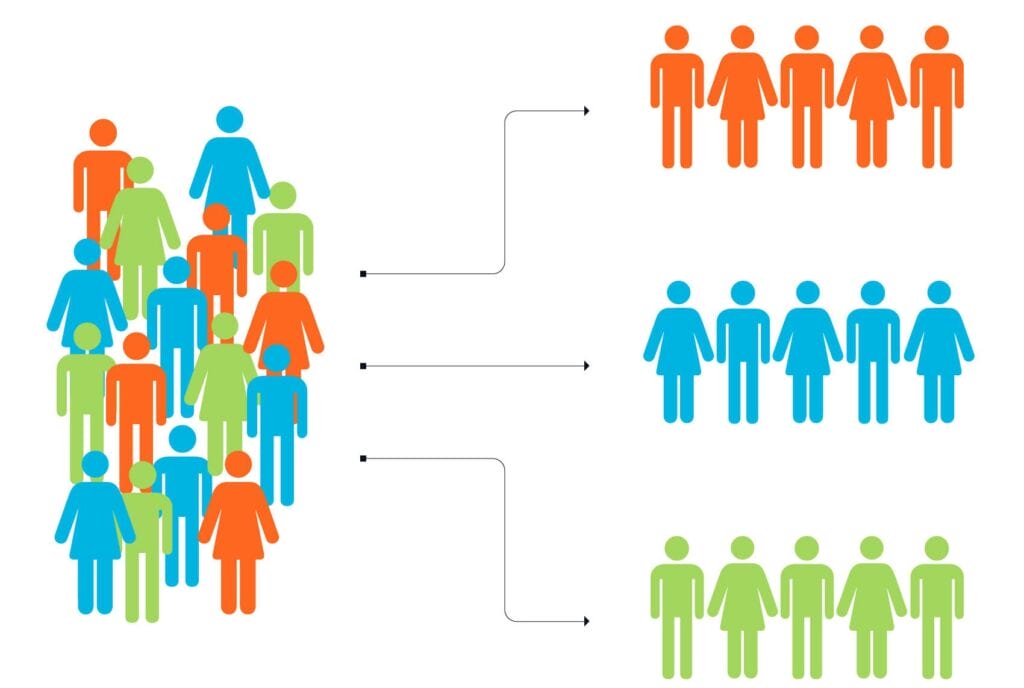
When people search for comparable goods or services that you are advertising for, such as “Roofing Services,” “Home Improvement,” and “General Contracting & Remodeling Services,” choosing an audience increases traffic and impressions.
Choose “Observation” as the targeting configuration. This guarantees that audience segments alone will not limit the reach of your audience targeting.
Manual CPC and Bidding
You must decide how much of an average daily budget you are willing to commit to your campaign based on your personal preferences. It’s crucial to remember that external factors such as your location and the level of competition in your industry and niche will impact your manual cost per click, or CPC.

On the right side of your screen, you’ll see an estimate of your campaign’s expected performance based on your budget amount, as well as a preview of your campaign optimization score. Your expected weekly clicks, weekly expenses, and average CPC are a few of these estimates. Remember that these are only estimates and may not be exact. If you implement the appropriate tactics, your Google AdWords could surpass Google’s estimates.
You also have a number of choices with Google Ads regarding the focus of your bidding strategy, including clicks, conversions, and impressions.
For your advertisement, you can also choose to set a maximum cost-per-click (CPC) bid limit. This implies that you won’t incur charges exceeding the specified maximum CPC if someone clicks on your advertisement. Since we don’t want to bid only on new clients, we should skip the customer acquisition section.
Perform the right keyword research
Planning your campaign’s keywords is a crucial step when using Google AdWords for roofing. Choosing the appropriate keywords can propel your company to the top of the search engine rankings. This section will teach you how to find relevant keywords and keep your competitive advantage by focusing on the appropriate search terms.

Begin by generating a list of search phrases that prospective clients might use to find a roofing service. Consider their requirements, as well as potential Google searches. After compiling a list of these terms, verify them by using resources such as Google’s Keyword Planner to identify related terms and obtain information about search volume and competition.
In your campaigns, you should take into account the following keyword types: phrase match, exact match, and broad match modifier. Each serves a distinct function and helps you successfully connect with your target audience.
- When using exact match keywords, the searcher must enter the precise word or phrase that you have selected. This guarantees highly targeted traffic and can improve the effectiveness of your advertisement. You could use “roofing repair services” as an example of an exact match keyword.
- Phrase-match keywords are a little more flexible because they let you change the search query slightly. They can have more words before or after the keyword, but they must still include your selection. For example, a phrase match of “roofing repair services” may appear for queries such as “best roofing repair services.”
- The most inclusive match type is the broad match modifier, which enables Google to display your advertisement to users who enter a wider range of queries that contain the keywords you have chosen.
Compile a list of pertinent keywords for every match type in order to optimize the performance of your Google Ads campaign. This strategy makes sure that a variety of prospective clients see your advertisements, regardless of how they look for your roofing services.
Another piece of advice is to monitor the performance of your keywords throughout the campaign. By doing this, you can make the necessary changes, like stopping low-performing keywords and modifying your ad copy depending on which terms result in the most conversions.
Investing time and energy in keyword research and selection will lay the groundwork for a Google Ads campaign that is successful in driving traffic and conversions for your roofing company.
Write persuasive advertising copy
Call-to-action (CTA) and ad copy optimization are essential for creating an effective Google Ads campaign for roofing contractors. In order to make sure that the text in your advertisements not only speaks to your target audience but also motivates them to take the desired action—such as calling or visiting a website—this strategy entails carefully crafting the text.

We know how effective persuasive advertising copy can be. The goal is to craft a compelling story that speaks directly to the homeowner in need of roofing services, not to stuff the advertisement with keywords. For example, using slogans like “Get a Free Roof Inspection Today” or “Fast, Reliable Roof Repair” can work well because they highlight prompt service and provide value by way of a free inspection, addressing common issues raised by homeowners.
Organize your account
It’s crucial to structure your Google Ads campaign for your roofing services properly when you first set it up. A well-planned campaign can improve both the effectiveness of your advertisements and the return on investment (ROI) of your advertising budget.
Create an advertising campaign that highlights your roofing services first. Sort your ads in this campaign into distinct ad groups, each focusing on a particular service you provide, like roof replacement, roof repair, or roof installation. This can improve the relevancy of your ad text and make it more appealing to your target market.

Make a list of relevant keywords that potential customers might use to find your roofing services for each ad group. To address various search intents, make sure you’re utilizing a combination of broad, phrase, and exact match keywords. Use phrases like “emergency roof repair,” “roof repair,” or “best roof replacement near me.”
After you’ve sorted your keywords, create enticing ad copy that highlights your experience and the advantages of your services. Draw attention to competitive advantages such as quick response times, free quotes, and warranties. Use ad extensions to offer more details, such as call extensions to entice customers to contact you or location extensions to show your address.
You should think about putting the following tactics into practice to make your PPC campaigns more successful:
Set budgets and bids judiciously
Divide your budget and bid amounts according to each ad group’s market competitiveness and relevance. You can start with Google’s suggestions and make any necessary adjustments.
Make use of negative keywords
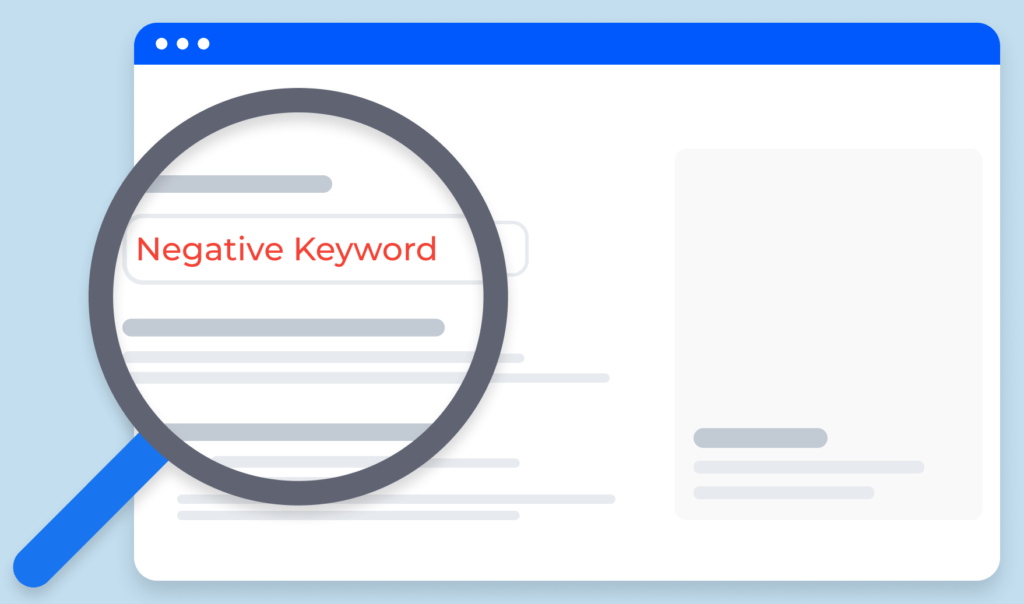
Create a list of negative keywords to weed out terms like “roof repair tutorial” or “DIY roof repair” that could cause clicks on irrelevant ads.
Optimize with regular monitoring
To increase ROI, evaluate your campaign’s performance frequently and make necessary adjustments. To improve results, test new ad variations, refine keywords, and adjust bids.
You may raise your profile and draw in quality leads for your roofing services by strategically organizing your PPC advertising campaign.
Additional Tips to Optimize Your Google Ad Account Successfully
Once your advertising campaign is up and running, you’ll need to monitor your ads and metrics in order to continuously optimize it.
Here are some additional pointers for getting the most out of your Google AdWords campaign.
Investigate Recommendations
Google will occasionally offer recommendations for your campaigns under the ‘Recommendations’ tab on the sidebar to the left. Google will provide several suggestions and ideas for changes to your account based on the data and insights they gather.
Remember, these are recommendations from a robot, so proceed with caution. They might be helpful, but if you don’t know what you’re doing, they might negatively impact the performance of your account.
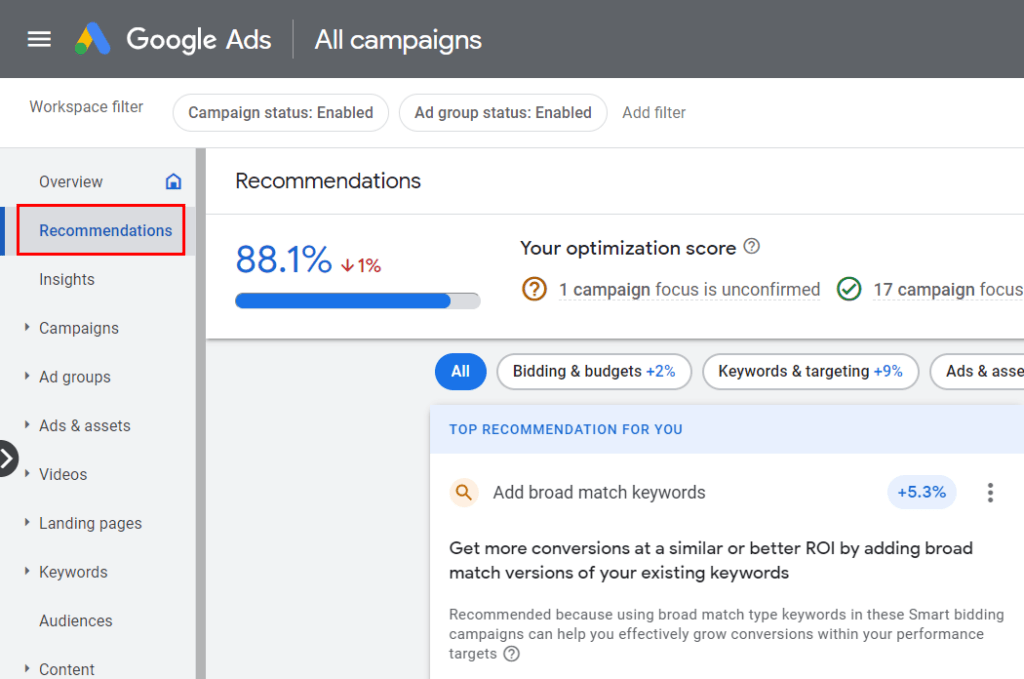
In order to maintain our partner badge as a Google Partner, we must maintain all of our accounts at or above a 70% recommendation score. By clicking the three vertical dots, you can choose to ignore recommendations that appear to be a waste of money or could interfere with your account.
Maintain Tight Ads and Keywords
Google loves to waste money, and they’ll use every last dime to further their own interests. Don’t overdo it; try to limit the number of exact match or phrase match keywords in your account.
To maximize the benefits of Google’s advertising system, use one batch of relevant keywords for each ad group. Make sure the focus of your advertisements is roof repair services, if that’s what you’re marketing.
Similarly, place all of those advertisements about installations in a different ad group if your goal is to acquire more jobs involving the installation of roofs. Google is constantly experimenting and tweaking their algorithms to determine the most effective search ads and keywords.
You can use ‘Ad Preview and Diagnostic’ to verify the correct alignment of your keywords and ads.
Keep an eye on your search terms
If you use broad-match keywords, you will encounter numerous search terms that do not precisely match the keywords in your account. To avoid wasting money on pointless keywords, we strongly advise using exact match and phrase match-based keywords.
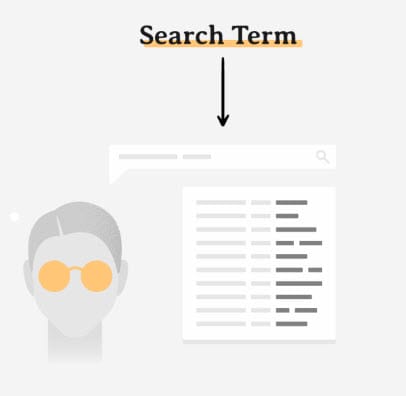
Google will still display your ads for “similar” terms even if you are using highly targeted keywords. Make sure to add any search terms you don’t want to appear for to your list of negative keywords, and keep an eye out for these queries if you find them in your account.
Attempt to get a high CTR (Click-Through-Rate)
It is important to ensure that the click-through rate (CTR) of your ads, ad groups, and campaigns are all high. This informs you that searchers are responding favorably to your ads and that the copy in your ads is working well.

We determine the CTR of an ad group or campaign by dividing the number of clicks received by the total number of impressions. For these campaigns, your click-through rate (CTR) should be at least 3%, but some of our contractor clients have seen CTRs of 20% or higher.
Track your conversion rates
Conversion rates help determine the efficacy of your landing pages, just as CTR can help demonstrate the performance of advertisements. More clicks on your pages result in leads if your conversion rate is high.
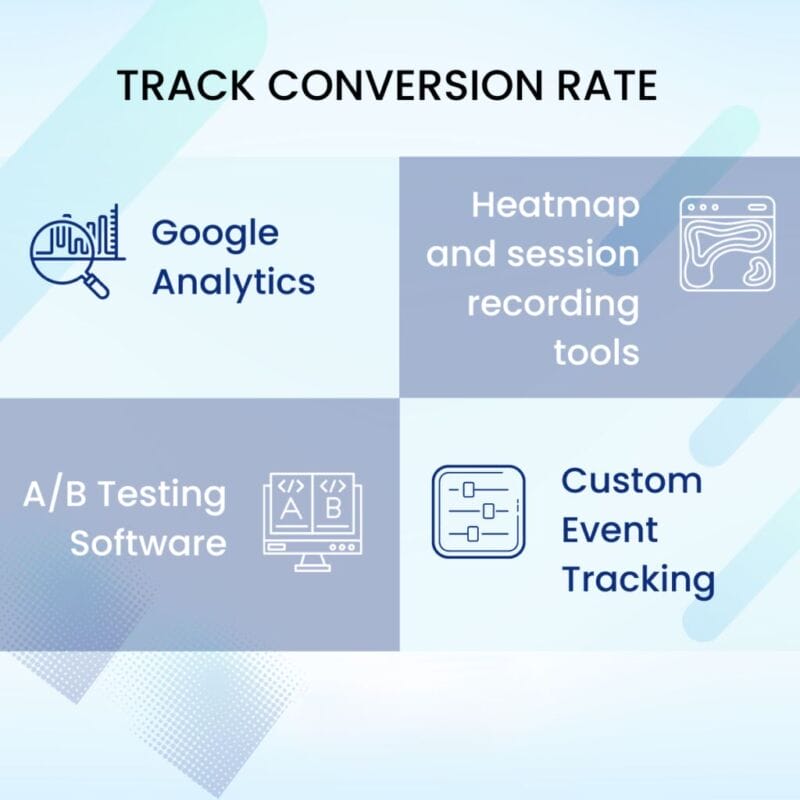
A lower conversion rate may indicate that fewer people are following through from your landing page and that you are not effectively marketing your service. It might also indicate that your keywords and messaging are not compatible.
The ratio of the number of clicks to conversions on your page is what determines your conversion rate. You can be sure that 3% and above is respectable; however, we have contractor clients with 20%+ conversion rates. Conversion rates vary by industry and offerings.
Disable Underwhelming Ads
You should think about turning off an ad and testing a newer one in its place if you’ve been running your campaign for a while and you see that one of your ads has a low click-through or conversion rate.
As previously said, a CTR of less than 3% ought to raise red flags. To split-test them, you can either make changes to the existing ad or create a new one.
Utilize the maximum number of ad extensions.
Creating ad extensions allows you to add extra features to individual ads or campaigns. Not every one of your extensions will show up every time; instead, Google will randomly choose and rotate them based on which ones work the best.
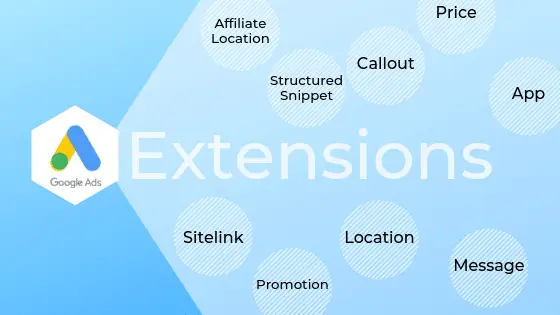
These ad extensions take the following forms:
- Callout extensions
- Sitelink extensions
- Image extensions
- Structured snippets
- Location extensions
- Call extensions
Try to fill out the maximum number of ad extensions. Being comprehensive will pay off for you because Google will reduce your average cost per click, and you will typically have a higher click-through rate.
Targeting specific audiences and demographics
If you own a roofing business, you might also think about focusing on specific groups of people who are more likely to require your services. You have the option to concentrate on specific in-market demographics.
- Real Estate > Commercial Properties
- Business Services
- Home and Garden > Home and Garden Services > General Contracting and Remodeling Services
- Home and Garden > Home and Garden Services > Roofing Services
Additionally, you can target specific demographics that best fit your clientele, such as:
- Married
- Homeowners
- Ages 35–65+
- Large employer (250–10,000 employees)
- Parent
- Female
- Top 10% Household Income
You have the option to target only those who meet these criteria, or you can start your ad campaigns in observation mode and bid more on these particular targets.
Final Thoughts on Using a Roofing PPC Campaign to Grow Your Business
Google AdWords is one of the most effective methods to quickly expand your roofing company if you want to see immediate results. While it’s easy to waste money on low-quality leads, following this Google AdWords guide will help you secure more profitable and higher-quality leads.
Do you need help running Google AdWords for your roofing business?
SwiftPropel can manage it for you. Schedule a free strategy session with our experts today to start growing your company.

Supriti is a seasoned Content Writer at SwiftPropel, boasting over 8 years of experience in SEO content writing. Her expertise lies in crafting compelling, search-engine-optimized content that not only engages readers but also ranks highly in search results. At SwiftPropel, Supriti combines her passion for storytelling with a deep understanding of SEO strategies to deliver content that drives traffic and converts leads.